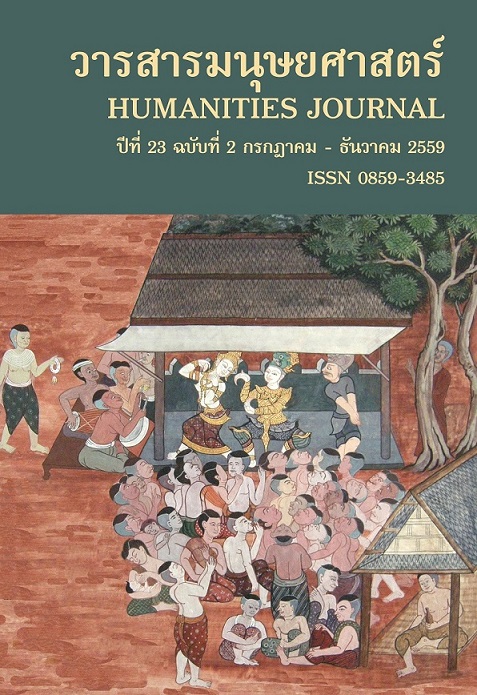ความซับซ้อนของนามวลีแปลงดัชนีบ่งชี้ความยากง่ายของตัวบท: กรณีศึกษาหนังสือเรียนวิชาภาษาไทยระดับชั้นประถมศึกษาปีที่ 1-3 Complexity of Nominalized Constructions as Text Difficulty Indicator: A Case Study on Thai Textbooks, 1st–3th Grade
Main Article Content
Abstract
ความยากหรือง่ายของตัวบทอาจพิจารณาได้จำกหลายปัจจัย หนึ่งในนั้นคือความยากง่ายของประโยคซึ่งโดยทั่วไปสามารถวัดจำกจำนวนคำที่ปรากฏในประโยคนั้น แต่เนื่องจากภาษาไทยไม่มีการใช้เครื่องหมายบ่งชี้ประโยค งานวิจัยนี้จึงเสนอวิธีการวัดความยากง่ายเชิงวากยสัมพันธ์ผ่านโครงสร้างนามวลีแปลงในภาษาไทย บทความนี้มีวัตถุประสงค์เพื่อศึกษาความยากง่ายของตัวบทในหนังสือเรียนวิชาภาษาไทย ระดับชั้นประถมศึกษาปีที่ 1–3 ผ่านการศึกษานามวลีแปลง การ- และ ความ- โดยจะศึกษาทั้งทางด้านคำและจำนวนคำที่ปรากฏในนามวลีแปลง และรูปแบบความซับซ้อนของโครงสร้างนามวลีแปลง ผลการศึกษาพบว่า คำที่ปรากฏตามหลังตัวบ่งชี้นามวลีแปลง การ- และ ความ- ในแต่ละระดับชั้นมีจำนวนและความหลากหลายที่เพิ่มมากขึ้นตามระดับชั้นที่สูงขึ้น จำนวนคำโดยเฉลี่ยที่ปรากฏในนามวลีแปลงมีแนวโน้มเพิ่มขึ้นตามระดับชั้น และในระดับชั้นที่สูงกว่าจะพบรูปแบบโครงสร้างซับซ้อนที่หลากหลายมากกว่า ผลการศึกษาจึงยืนยันว่าตัวบทในระดับชั้นประถมศึกษาปีที่ 1–3 มีความยากเพิ่มขึ้นด้วยวิธีการวัดที่นำเสนอ
Text difficulty could be evaluated from many factors. One of those is the difficulty of sentence structure, which is usually measured from the number of words in a sentence. Since sentence boundaries are not explicitly marked in Thai, we propose to measure this syntactic complexity through the number of words in a nominalized construction, marked with /kaan0/ and /khwaam0/. The purpose of this paper is to examine text difficulty in Thai textbooks, 1st–3th grade, using syntactic complexity of nominalized constructions. The results show that collocates after /kaan0/ and /khwaam0/ increase in terms of number and variety in the higher level. The mean of the number of words in nominalized constructions increases, and more complex patterns of nominalized constructions are found in the higher level. The finding indicates that Thai textbooks, 1st–3th grade, tend to be more difficult in the higher level according to this measurement.


